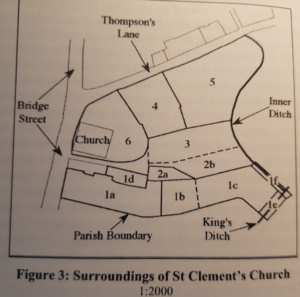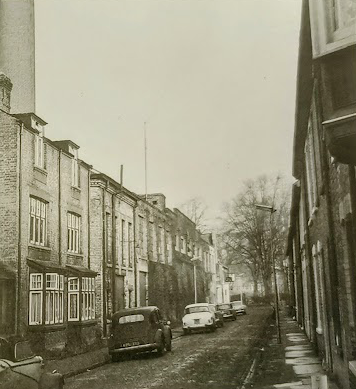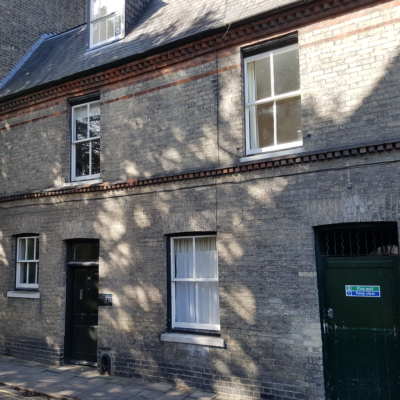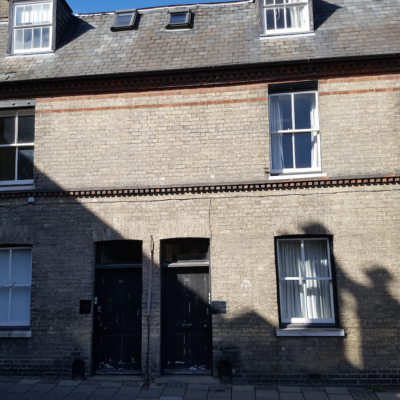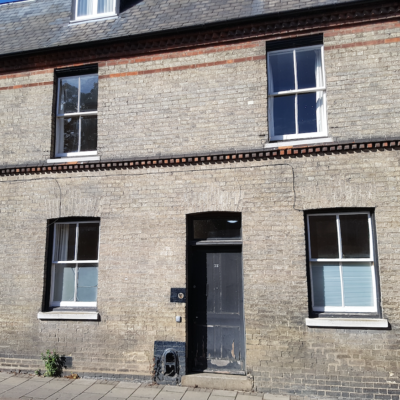Search by topic
- archaeology
- Building of Local Interest
- charity
- church
- crime
- dressmaker
- fire
- Great Eastern Railway
- Listed building
- Mapping Relief
- medieval
- oral history
- poverty
- Public House
- Rattee & Kett
- Religious House
- Roman
- scholar
- school
- Then and Now
- tudor
- women
- work
- world war one
- world war two
Search by text
The Brewery Garden Site (Tassell’s Garden)
History of the Brewery Garden Site
In the 13th century area 5 (on the map) contained the farmyard and associated buildings of Richard Laurence. T E Faber (An Intimate History of the Parish of St Clement’s, 2006), the source of the following description, suggests that Laurence lived in the house on the opposite end of Aunger’s Lane (Thompson’s Lane) for which he paid a rent to Barnwell Priory.
There is no evidence of what happened in the decades following the grant of the property to William and Margaret de Lolleworth in 1318. In the 15th cent, it formed part of the Harlestons’ manor for it was with with the manor that it came to St John’s College in 1533. Three surviving deeds at the end of the 14th cent may relate to the Harleston’s acquisition of the land.
The rentals for 1533 – 35 feature a garden call ‘le Taselyarde’ with four tenements on Harleston Lane (Thompson’s Lane) which must have been to the east of the garden. From this time until 1544 William Browne paid the rent for the garden; he left it outright to his wife.
In 1545 a new lease was made out to Miles Prance for the ‘tasshels garden’. The garden measured 31 yards east to west and 46 yards north to south and the rent for 5s 4d.
In 1585 the lease was renewed by Miles’s widow. In the same year the lease was transferred to John, probably her son.
In 1610/11 lease taken over by Henry Alvey, fellow of St John’s, still paying 5s 4d. Alvey also had an adjacent tenement. In a codicil to his will a few months before his death in 1627, his property is described: first, ‘ the greate huse wherein wee [i.e. Henry himself, his widowed sister, and apparently his brother Richard plus Richard’s wife and their unmarried grown-up daughter] dwell together with the gardens and the howse next adioyning haveing no chymney‘, and secondly, ‘the first howse of the rowe being chambered‘, ‘the second next to it‘, ‘the third‘ and ‘the fourth.’
This combined lease at a rent of 12s was granted to James Percival, taylor, in 1648 and to William Jones, barber, in 1667, both of whom lived in the ‘greate house’. these payments continued until 1700.
In 1734 there were still five houses on Tassell’s garden but the arrangement was different. So the lifetime of some of the original buildings put up by Miles prance had been less than 200 years. Even the ‘great house’ had been rebuilt by 1734 as two houses.
In 1748 the plot of the ‘great house’ together with Tassell’s garden had been let to the brewer John Sparkes. Sparkes ran the Thompson Lane Brewery at the time in partnership with Thomas Ewin (who himself may have been living opposite Tassell’s garden in the Thompson’ house.)
1767 the brewery was bought by John Gillam and he probably bought the lease of Tassell’s garden.
The freehold of the area remained with St John’s College from 1533 until John Purchas who took a lease of it in 1791 and bought the freehold in 1795. Some of the land sold to Purchas may have been used before 1791 by occupants of the house built on the north side of Thompson’s Lane by Roger Thompson III but Purchas pulled down that house and it seems it was he who turned the whole into a grand garden for the new houses which replaced it. The 1795 conveyance states ‘ten messuages formerly stood since pulled down and on part are now erected a coach house stable or other buildings and the residue is now used as a garden and yard.’
Throughout the first half of the 19th cent. the garden and coach house etc. were owned by members of the Foster family. When the Fosters sold up in 1859 Swann Hurrell took over. The garden with its grapehouse and summerhouse is visible in the 1886 OS map.
Contribute
Do you have any information about the people or places in this article? If so, then please let us know using the Contact page or by emailing capturingcambridge@
License
This work is licensed under CC BY-NC-SA 4.0





